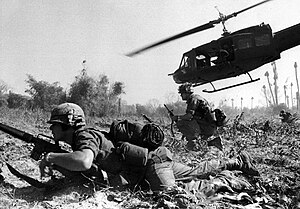| Pleiku campaign | |||||||
|---|---|---|---|---|---|---|---|
| Part of the Vietnam War | |||||||
 Bruce P. Crandall's UH-1 Huey helicopter and U.S. Army Air Cavalrymen under fire at LZ X-Ray | |||||||
| |||||||
| Belligerents | |||||||
|
|
| ||||||
| Commanders and leaders | |||||||
|
Vĩnh Lộc (ARVN III Corps) Robert McNamara (US Secretary of Defense) Stanley R. Larsen (IFFV HQ) Harry Kinnard (1ACD HQ) Richard T. Knowles (1ACD FCP) Harlow Clark (1st AC Brigade) Ray Lynch (2nd AC Brigade) Thomas W. Brown (3rd AC Brigade) Harold G. Moore (1/7) Robert McDade (2/7) Walter B. Tully (2/5) |
Chu Huy Mân (B3 Field Front) Nguyễn Hữu An (Fwd CP) Tô Định Khẩn (32nd Rgt) Vũ Sắc (33rd Rgt) Lê Tiến Hòa (66th Rgt) Phạm Công Cửu (66th Deputy Cmdr) † Lã Ngọc Châu (7/66) Lê Xuân Phôi (8/66) † Nguyễn Văn Định (9/66) | ||||||
| Units involved | |||||||
| II Corps Force; 1st Air Cavalry Division; 3AC B-52 bombers (Guam). | B3 Field Front Force (three regiments, ~5,500 men) | ||||||
| Casualties and losses | |||||||
| ~600 (excluding Battle of Ia Drang) | U.S claimed: ~6,000 | ||||||
The Pleiku campaign took place from 23 October to 26 November 1965.[1] II Corps Command named it Pleime campaign, with a slightly different starting date of 20 October instead of 23 October,[2] consisted of three operations:[3]
- Operation Dân Thắng 21(20 to 26 October 1965), the first Pleime preparatory phase, was the relief operation of the besieged Pleime camp.
- Operation Long Reach, which was the Chu Pong phase, comprising two operations: Operation All the Way (27 October – 9 November 1965) conducted by the 1st Air Cavalry Brigade and Operation Silver Bayonet I (9–18 November 1965) conducted by the 3rd Air Cavalry Brigade[1] against the NVA, which culminated in the Battle of Ia Drang occurring from 14 to 18 November 1965.
- Operation Than Phong 7 (18–26 November 1965) conducted by the ARVN Airborne Brigade in conjunction with the 2nd Air Cavalry Brigade conducting Operation Silver Bayonet II in the Ia Drang area. It was the final Ia Drang exploitation phase.[4][5]
This joint ARVN-US campaign was characterized by a special procedure of "common operational concept, common intelligence, common reserve, and separate command".[3][6]
- ^ a b Kinnard, p.1
- ^ The 20th was the day II Corps launched Pleime campaign (Vĩnh Lộc, p. 68) and the 23rd was the first day the Air Cavalry troops joined the battle with the arrival of Task Force Ingram in Pleiku city (Kinnard, p. 18; Vinh Loc, p. 53)
- ^ a b Vĩnh Lộc, p. 68
- ^ Vinh Loc, p. 15
- ^ Kinnard, p. i
- ^ Vinh Loc, p. 101